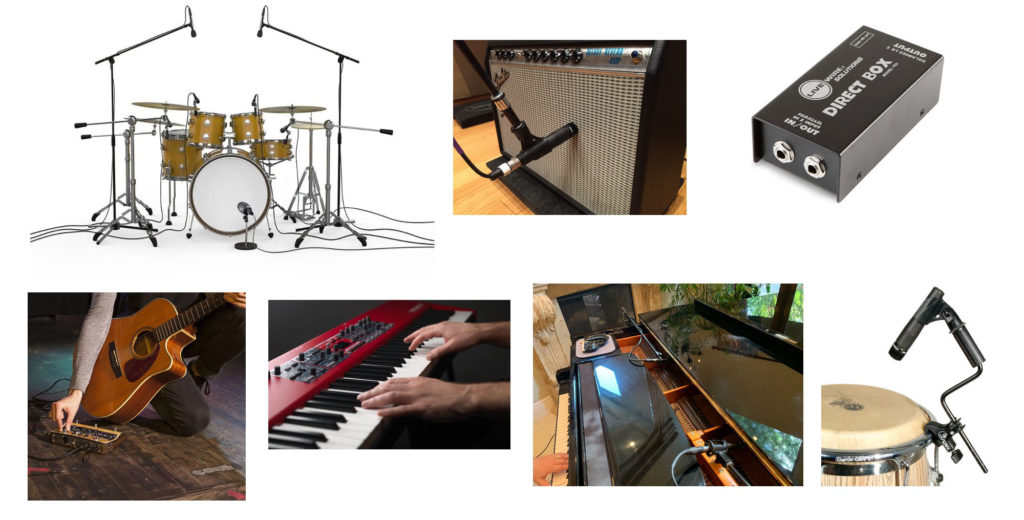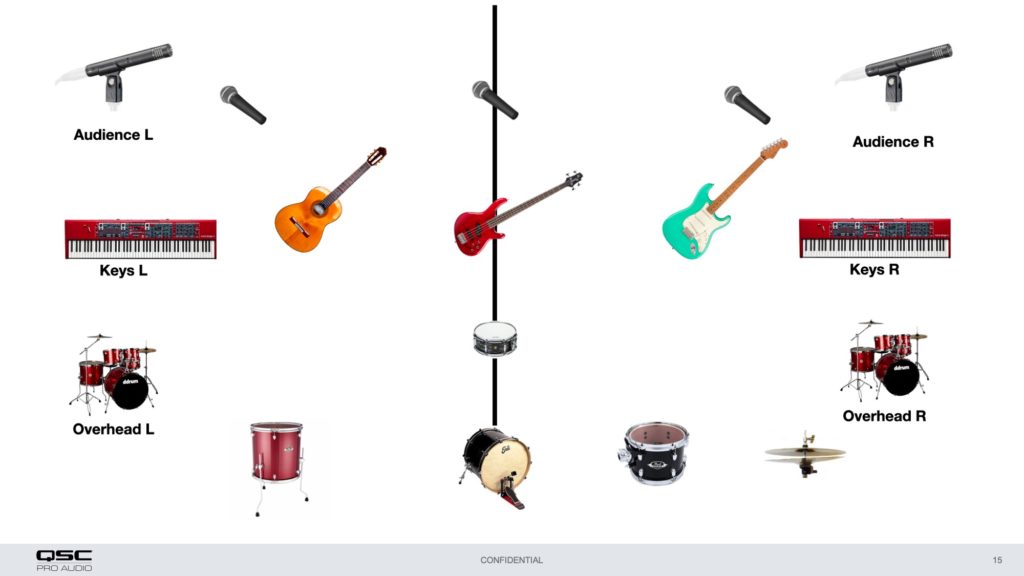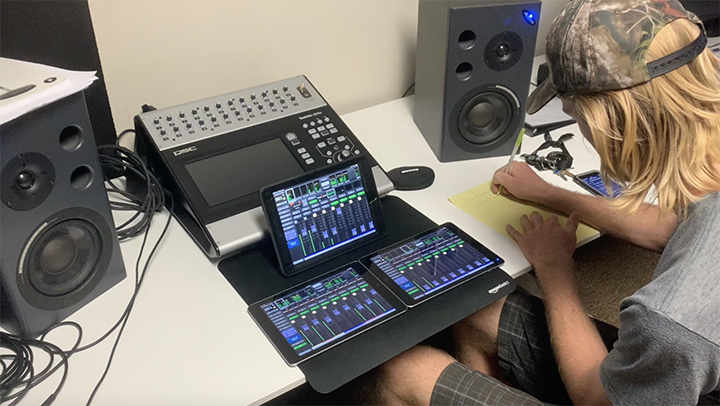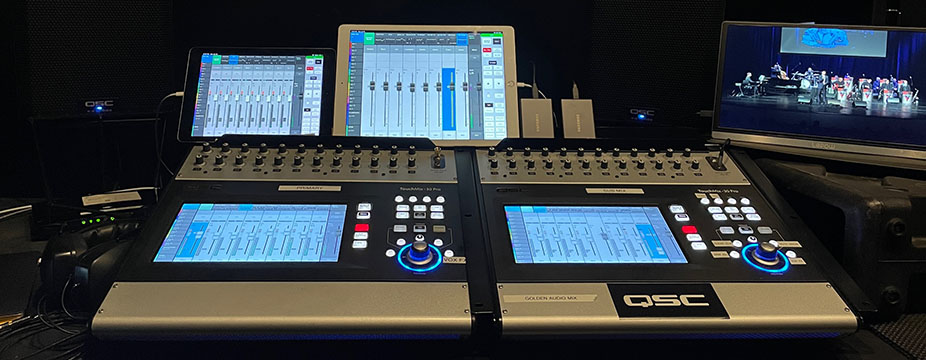In this pandemic-induced era, numerous venues and churches have been compelled to embrace the realm of livestreaming. Whether you’re a newcomer to the world of livestreaming or seeking ways to enhance the audio quality of your broadcasts, this article will prove invaluable.
The main production goal of a streaming broadcast mix is to recreate the live worship experience as much as possible for the online listener. With this in mind, let’s dive into best practices for broadcast mixing for your live stream.
5 Best Practices for Broadcast Mixing for Your Livestream
#1 – If You Want It to Be Heard, Mic It or Plug It In
When it comes to capturing everything in your broadcast mix, this is the rule of thumb; “If you want it to be heard, mic it or plug it in.”
Mic each drum, electric guitar amps, percussion, acoustic piano and don’t forget to set up a pair of audience mics. Plug in anything that uses a direct box (DI), like acoustic guitars and keyboards, etc.

Microphones and direct boxes are like ears for your broadcast mix. Just because something is loud in the house to your ears, doesn’t mean that the broadcast mix can hear it.
#2 – Create a Dedicated Broadcast Mix for Your Livestream
Do not send your main house mix to your live stream. Your main mix should be dedicated to the house only. When you’re mixing the house, you’re accounting for acoustic noise in the room. You may not choose to reinforce every instrument at the same volume. Sending your main mix to your livestream will result in a unbalanced mix for the online listener.
Instead, use the auxes/buses on your mixer to create a dedicated stereo broadcast mix for your livestream. See video on how to create a stereo aux/bus mix.
#3 – Make Use of Your Stereo Field
Pan instruments to the left and right of your stereo field. This helps create delineation between instruments resulting in a wider, fuller sounding mix. Generally, when applying panning for a broadcast mix, you’ll want to place instruments in your sonic landscape according to where the musicians are positioned on stage. Spoken word should always be mixed up the center. See video on panning for broadcast.

#4 – Pay Close Attention to the Amount of FX in Your Broadcast Mix During Your Worship Time
When used in the proper amount, FX, like reverb and delay, will create the feeling of being in the same space with the audience. If you’ve listened to your mics in the broadcast mix without FX, you’ll find they’re very dry and in your face.
As you’re listening to your dedicated livestream mix, use your ear when adjusting the FX returns for your broadcast. You don’t want your band to feel like it’s swimming in FX but you do want the feeling of space.
#5 – Monitor Your Broadcast Meters So That They’re Hitting Near the Same Level Throughout Your Service
The online listener should never have to adjust their volume. It’s the job of the person running the broadcast mix to monitor the broadcast meters and make the proper adjustments during the service so that those meters are hitting at about the same level.
Keep the output meter for your broadcast mix in front of you at all times. Whether that means customizing the fader banks on your console to include the broadcast meter or using an iPad or tablet to display it in front of you, that meter and access to the broadcast master fader should be always in your line of sight.
4 Options to Run a Broadcast Mix
Option 1 – Run a Broadcast Mix on a Separate Mixing Console
For ultimate control of all processing of your input channels, run a separate broadcast mix from a separate mixing console. In this scenario, the front of house and broadcast mixing consoles are sent their own set of input signals from the stage.
In the analog world, this is accomplished by using an audio signal splitter which distributes or splits an audio signal into two.
Many digital mixers have the ability to share the pre amp signal from a digital stage box via Dante or whichever digital protocol is being used to send and receive signal.
Mixing front of house and broadcast from two separate mixing consoles is a considerable investment in gear and audio personnel for most churches which is why you’ll often see this configuration in larger churches.
Most mid-sized and more intimately sized churches are under pressure to produce a great sounding livestream mix with only the one console they have in the main worship center. So, let’s look at options for running a stellar live stream mix from one console.
Option 2 – Run a Broadcast Mix in Post Fader
If you’re one person managing FOH, monitors and the broadcast mix at the same time, then this is the best option for you. Post fader means that any time you make a level change to a channel fader in your main mix, that channel in your dedicated broadcast mix will reflect the level change as well. See video on post fader.
Before you start working with your broadcast mix, balance your house mix. Your post fader broadcast mix will be set based on the fader placement of your house mix.
When running your broadcast mix in post fader, you’ll need to implement something I call broadcast compensation. Broadcast compensation is compensating in your broadcast mix for the lack of level being sent from your main mix. You may find yourself applying broadcast compensation to instruments that produce significant acoustic noise like drums or instruments that use loud amps, like electric guitars and bass. See video on broadcast compensation.
Option 3 – Run a Broadcast Mix in Pre Fader
This option is perfect if you have an additional person dedicated to mixing broadcast.
Pre fader means any changes you make to the main faders will NOT affect the broadcast mix. Because of this you will NOT have to compensate for anything generated from the main mix. The volumes levels in your broadcast mix are running totally free from the main mix.
In the pre fader broadcast scenario, the person mixing can be in an isolated space with studio monitors to reference the service. This allows for a truer sense of what the online listener is experiencing. The person mixing is now able to make fine adjustments to the levels in the mix since they are now free from hearing noise bleed from the main service meeting space.

By connecting via wi-fi multiple tablets or iPads to your FOH console, you can create a whole virtual broadcast console.
Option 4 – Run your broadcast mix from a digital audio workstation (DAW) on a computer.
For example, Garage Band, Logic, Pro Tools or Reaper.
This is an affordable method that is fast becoming a popular way to produce a broadcast mix. Unlike mixing broadcast from the same mixer as FOH where channel EQs and dynamics are shared between the main mix and broadcast mix, mixing from a DAW gives you complete control over every aspect of the broadcast. It’s the equivalent of having a completely dedicated console just for your broadcast mix.
However, with such great flexibility and control comes complexity. Not everyone has the chops to create their own great sounding mix in a DAW. There are wonderful DAW template resources available from companies like SundaySounds.com to help the novice user create a wonderful sounding mix. The user simply needs to connect the input channel signals from the mixer to the channels in the DAW and then adjusts the faders to their preference. See video on assigning mixer channels to a DAW.
It’s best to have a dedicated person running the DAW broadcast mix.
The Importance of Excellence in Livestream Broadcast Mixing for Church Audio
An engaging and well-balanced livestream will allow the online listener to focus their attention on the message being conveyed. For the person who happened to scroll across your church’s live stream on social media, their first impression of your church will be based on what they see and hear at that moment. These are a few reasons I encourage every church fellowship to pursue excellence in crafting a wonderful-sounding live stream broadcast mix.
Here are a few examples of broadcast mixes that I’ve done. The first clip, is from a contemporary service, and the 2nd is from a classical service at St Andrews Presbyterian Church in Newport Beach, CA.
